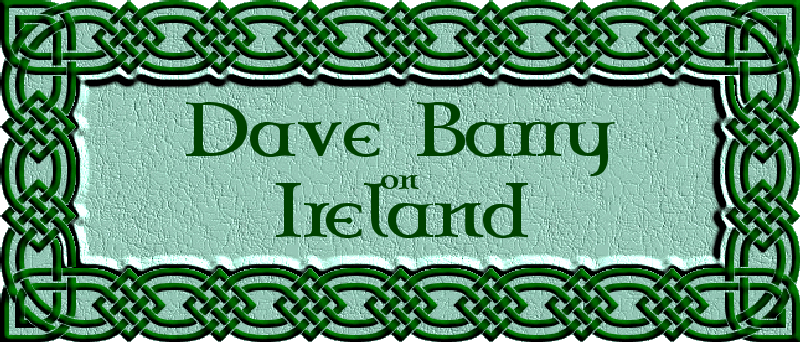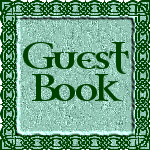|






Pub-Crawl
in Tractorland
Dave
Barry
The Boston Globe
Magazine The Boston Sunday Globe, August 6, 1995
I recently
spent a week in Ireland, and I can honestly say that I have never been
to any place in the world where
it is so easy to partake of the local culture, by which I mean beer. Ireland
also contains history, nice people,
enormous
quantities of scenery, and a rich cultural heritage, including (more on
this later) Elvis.
Geographically,
Ireland is a medium-sized rural island that is slowly but steadily being
consumed by sheep.
It consists
mostly of scenic pastures occasionally interrupted by quaint towns with
names such as
(these
are actual Irish town names) Ardfert, Ballybunion, Coole, Culleybackey,
Dingle, Dripsey, Emmoo, Feakly,
Fishguard,
Gweedore, Inch, Knockaderry, Lack, Leap, Lusk, Maam, Meentullynagarn, Muff,
Newmarket-on-Fergus,
Nutt's
Corner, Oola, Pontoon, Rear Cross, Ringaskiddy, Screeb, Sneem, Spiddle,
Spink, Stradbally, Tang, and Tempo.
Towns
are connected by a modern, state-of-the-art system of medieval roads about
the width of a standard
bar
of hotel soap; the result is that motorists drive as fast as possible in
hopes of getting to their destinations
before
they meet anybody coming the other way. The only thing that prevents everybody
from going 120 miles
per
hour is the nationwide system - probably operated by the Ministry of Traffic
Safety - of tractors being driven
slowly
by old men wearing caps. You encounter these roughly every two miles, rain
or shine, day or night. As an
additional
safety measure, the roads are frequented by herds of cows, strolling along
and mooing appreciatively
at the
countryside, reminding you very much of tour groups.
A typical
Irish town consists of several buildings, one of which is always a bar,
called a pub. Next to this, there will
typically
be another pub, which is adjacent to several more pubs. Your larger towns
may also have a place that sells
food,
but this is not critical.
Inside
the pubs you will usually find Irish people, who are very friendly to strangers,
especially compared to the
British,
who as a rule will not voluntarily speak to you until you have lived in
Britain for a minimum of 850 years. The
Irish,
on the other hand, will quickly start a conversation with you and cheerfully
carry it on at great length, with or
without
your help.
One evening
in a Dublin pub, I watch an elderly, well-dressed, cap-wearing gentleman
as he sat in the corner and, for
two
hours, struck up a lively conversation with everyone who sat within 10
yards of him, including a group of German
tourists,
only one of whom spoke even a little English. The man spoke to them in
a thick brogue on a variety of topics
for
several minutes, while they looked at him with the bright, polite smiles
of people who do not have a clue about what
is being
said to them.
You definitely
feel welcome in Ireland. But there's more to do there than just talk to
Irish people in pubs. You can also
drive
around the countryside, alternately remarking, "Look, sheep!" and "Here's
another tractor!" You can visit a bunch
of castles
built by the Normans, who at one point conquered Ireland despite being
called the Normans, which is, let's
face
it, not an impressive-sounding name. It's kind of like being conquered
by the Freds.
Probably
the best-known castle is the one in the town of Blarney that contains the
famous Blarney Stone. To get to it, you
have to climb steep, narrow, tourist-infested steps to the top of the castle;
there, a local man holds you as you
lean
out over the castle wall and kiss the Blarney Stone. Legend has it that
if you do this, you will give the man a tip. At
a castle
in a town called Kilkenny, I saw a local radio station doing a live remote
broadcast, featuring a "frozen-food
Challenge"
in which a local resident had to answer a multiple-choice question on the
history of refrigeration. She got
it right
and won a hamper of frozen foods.
But the
cultural highlight of the trip occurred in the town of Ennis, where a pub
called Brandon's had a sign outside
that heralded "traditional Irish music." This turned out to be a traditional
Irish Elvis impersonator. I realize
that
there are literally thousands of quality Elvis impersonators, and I'm sure
you've seen some excellent ones,
but
this one, in this unremarkable town in western Ireland, was beyond question
the worst Elvis
impersonator
in history.
He sang
along to a tape of instrumental Elvis tunes that he played on a sound system
that he never, not once in
two
hours, got adjusted right. Every time he'd start singing a song, the sound
system would screech and honk
with
feedback. Elvis would then whirl around and spend minutes at a time unsuccessfully
adjusting various knobs
while
he mumbled the lyrics, so that for most of the evening, all you saw was
Elvis' butt, accompanied by screeching
and
honking and vague off-key singing. Often, by the time he'd finished twiddling
the knobs, Elvis had lost track
of what
song he was singing; he'd frown into the distance, trying various tunes
until he thought he was on the right
track,
at which point the screeching and honking would start up, forcing Elvis
to whirl back around, like a man being
attacked
by bees, and treat the audience to another lengthy view of his butt.
The crowd,
which I will frankly admit was consuming alcoholic beverages, enjoyed this
performance immensely,
cheering
wildly at the end of each song. They like their fun, the Irish. I'm definitely
going back some day. Maybe
I'll
rent a tractor.


|